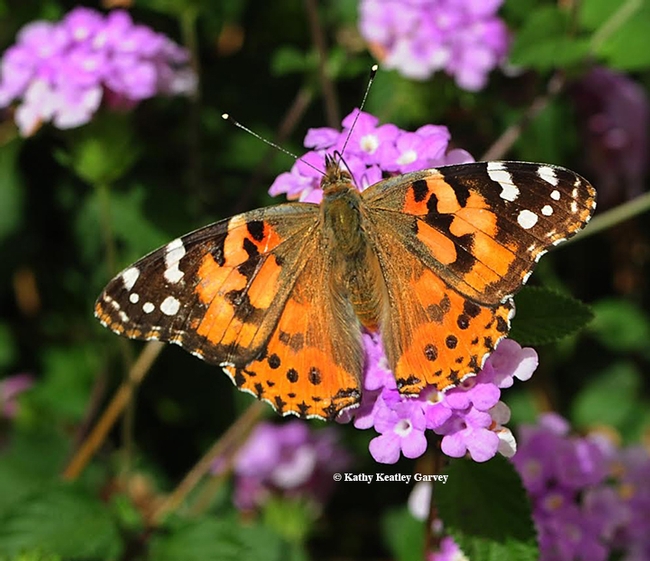- Author: Kathy Keatley Garvey

If you live in Alabama, Georgia, Kansas, Nebraska, Oklahoma or Texas, the United States Geological Survey (USGS) wants you to collect dead butterflies and moths and mail the specimens to its office in Lawrence, Kansas for its Lepidoptera Research Collection (LRC).
"These specimens will help USGS scientists identify contaminants and environmental factors which may be contributing to the decline of insect populations," the agency related on its website. "Citizen participation will ensure enough specimens throughout the nation are available to answer research questions."
They're specifically looking at the "occurrence of antibiotics, pesticides, hormones, and mycotoxins in Lepidoptera."
Said Julie Dietze, the USGS scientist-in-charge of the project: "There are some questions that can't effectively be answered without help from a lot of people. It's what makes citizen science so special and valuable. Collections like this one are important because they have the potential to provide scientists now, and 20 years from now, access to specimens. Without the specimens it will be far more difficult to answer questions related to contaminants and environmental health."
The deadline to submit the specimens is Nov. 1, 2023. However, the project, launched in April of 2023, may continue into 2024, according to the website. See more information or contact Dietze at juliec@usgs.gov. In addition, you can follow USGS on Facebook @USGeological Survey; YouTube @USGS; Instagram @USGS; or Twitter (now known as "X") @USGS.??
Chang Che of The New York Times published a piece on the project on July 27 and interviewed butterfly guru Art Shapiro, UC Davis distinguished professor emeritus, on the declining butterfly populations. Shapiro, who retired July 1, 2023, has been monitoring the butterfly populations of central California since 1972. He maintains a research website at https://butterfly.ucdavis.edu.
"Insects, the ballast of food chains and essential pollinators that help nourish entire ecosystems, are in rampant decline across the world," wrote Che, who mentioned that the U.S. monarch population alone has decreased 90 percent over the past 20 years. Scientists say that amounts to 900 million monarchs, Che pointed out.
Shapiro says the drop is likely a result of such factors as climate change, habitat loss and pesticides. He told Che that the sharp decline coincides with the implementation of neonicotinoids in agriculture. "And the same coincidence — if that's what it is — has been observed in the U.K. and in Europe.”
"Dr. Shapiro noted that recent heat waves had probably killed many of the butterflies people would be sending in," Che wrote. "He was supportive of 'anything that sheds some light on what is actually going on' with butterflies. But he cautioned that the study would most likely shed light on insect-specific factors of population decline such as pesticides, as opposed to environmental ones like heat waves and habitat loss."
Meanwhile, Shapiro told us today that "I am getting odd e-mails as a result of that NYT article. People are assuming I'm a Monarch maven. I'm not!"
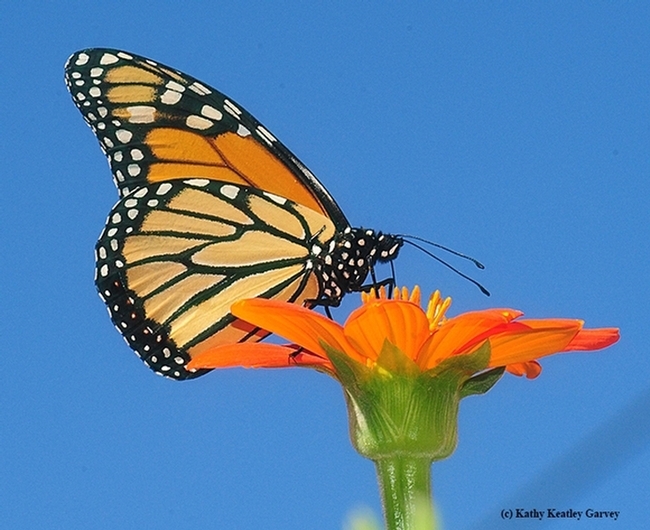
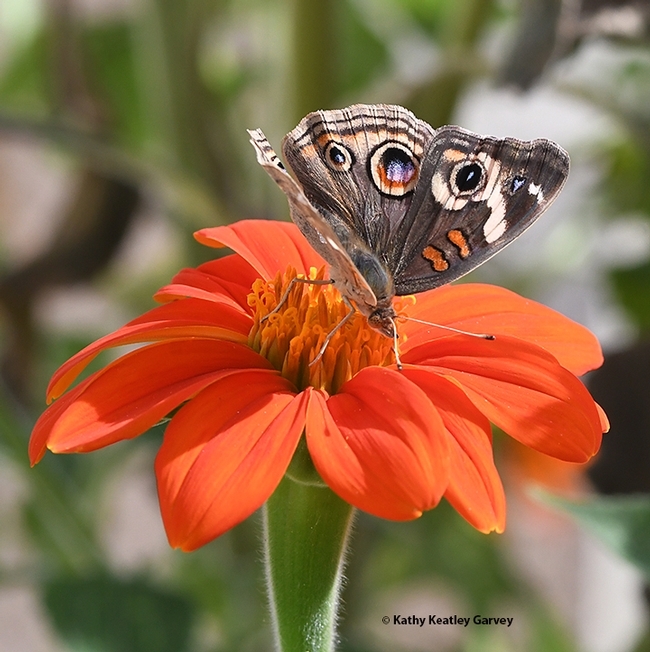
- Author: Kathy Keatley Garvey
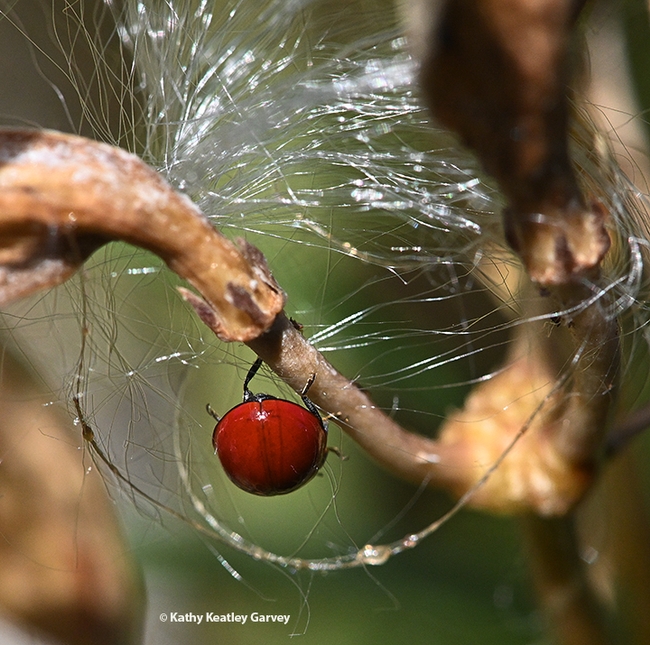
It's early morning, Aug. 20. A lady beetle is snacking on aphids on our native milkweed plant (where the monarchs are supposed to be, but aren't!). And then, apparently satiated, LB climbs a twig to the top of her Mt. Everest, looks around, unfolds her wings, and takes off.
The miracle of flight! The miracle of unpacking what's under those wings. The miracle of seeing it all happen.
"The ladybug is a tiny insect with hind wings four times its size," wrote Joanna Klein in her article,
Ladybugs Pack Wings and Engineering Secrets in Tidy Origami Packages, in the May 18, 2017 edition of The New York Times. "Like an origami master, it folds them up into a neat package, tucking them away within a slender sliver of space between its abdomen and the usually polka-dotted, harder wings that protect it.
"When it is time to take off, it deploys its flying apparatus from beneath its colorful shell-like top wings, called the elytra, in only a tenth of a second. And when it lands, it folds it back in just two. Switching between flying and crawling many times in a day, the ladybug travels vast distances."
Klein called attention to a study published in the May 17, 2017 edition of the Proceedings of the National Academy of Sciences. The authors, she said, detailed "just how the ladybug manages to cram these rigid structures into tiny spaces is a valuable lesson for engineers designing deployable structures like umbrellas and satellites."
It's the work of Kazuya Saito of the Institute of Industrial Science, University of Tokyo, Japan, and his colleagues, Shuhei Nomura, Shuhei Yamamoto, Ryuma Niiyama and Yoji Okabe.
The title? "Investigation of Hindwing Folding in Ladybird Beetles by Artificial Elytron Transplantation and Microcomputed Tomography."
The significance? "Hindwings in ladybird beetles successfully achieve compatibility between the deformability (instability) required for wing folding and strength property (stability) required for flying. This study demonstrates how ladybird beetles address these two conflicting requirements by an unprecedented technique using artificial wings. Our results, which clarify the detailed wing-folding process and reveal the supporting structures, provide indispensable initial knowledge for revealing this naturally evolved optimization system. Investigating the characteristics in the venations and crease patterns revealed in this study could provide an innovative designing method, enabling the integration of structural stability and deformability, and thus could have a considerable impact on engineering science."
The abstract? "Ladybird beetles are high-mobility insects and explore broad areas by switching between walking and flying. Their excellent wing transformation systems enabling this lifestyle are expected to provide large potential for engineering applications. However, the mechanism behind the folding of their hindwings remains unclear. The reason is that ladybird beetles close the elytra ahead of wing folding, preventing the observation of detailed processes occurring under the elytra. In the present study, artificial transparent elytra were transplanted on living ladybird beetles, thereby enabling us to observe the detailed wing-folding processes. The result revealed that in addition to the abdominal movements mentioned in previous studies, the edge and ventral surface of the elytra, as well as characteristic shaped veins, play important roles in wing folding. The structures of the wing frames enabling this folding process and detailed 3D shape of the hindwing were investigated using microcomputed tomography. The results showed that the tape spring-like elastic frame plays an important role in the wing transformation mechanism. Compared with other beetles, hindwings in ladybird beetles are characterized by two seemingly incompatible properties: (i) the wing rigidity with relatively thick veins and (ii) the compactness in stored shapes with complex crease patterns. The detailed wing-folding process revealed in this study is expected to facilitate understanding of the naturally optimized system in this excellent deployable structure."
But back to our little lady beetle in our pollinator garden. It's difficult to catch a lady beetle in flight. They don't fly when you WANT them to, and when they do fly, you and your camera are NOT ready. And when you and your camera ARE ready, all focused and everything, they change their mind or change directions. So, in keeping with our motto, "Don't poke 'em, prod 'em or pin 'em," we waited.
With the morning sun behind her back, LB finally obliged and took flight.
We managed to catch the action with a Nikon Z7 with a Nikon 105mm lens, manually focused: F-stop 16; shutter speed, 1/2500 of a second; and ISO, 5600.
Here's hoping LB will return. She missed a few aphids!
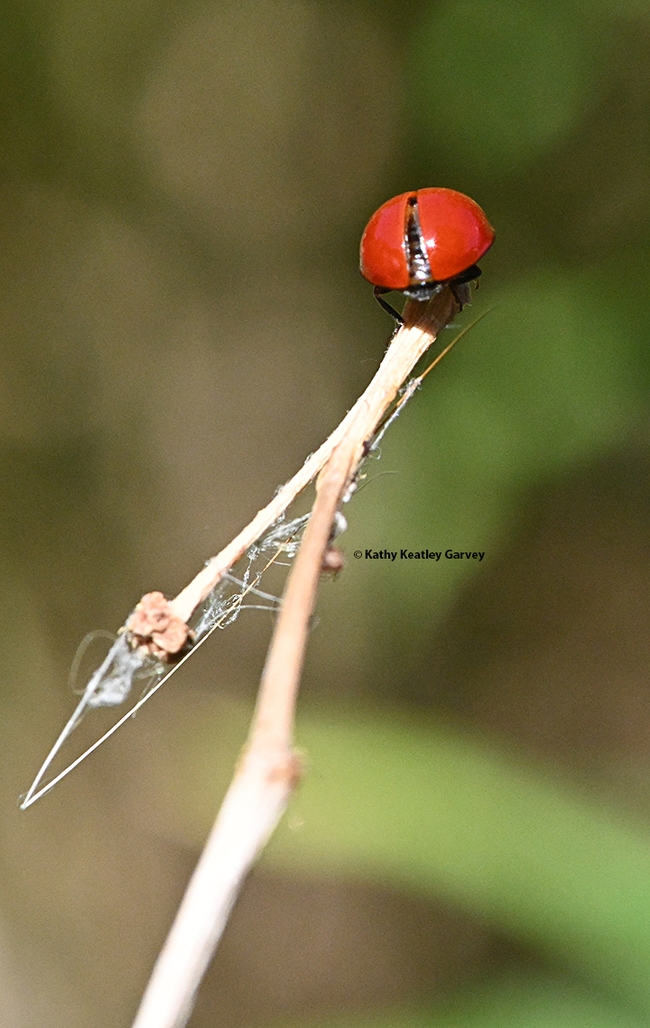
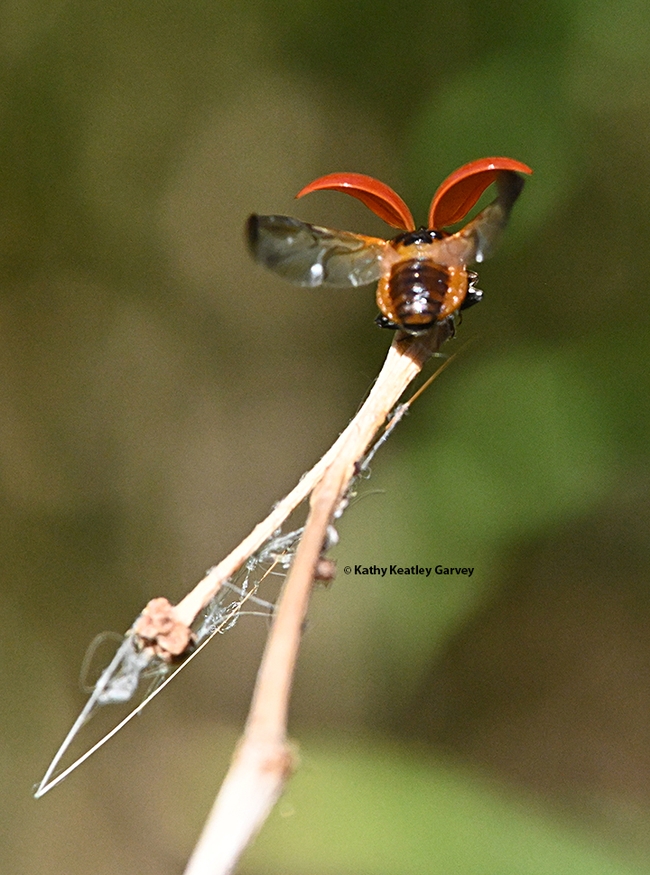
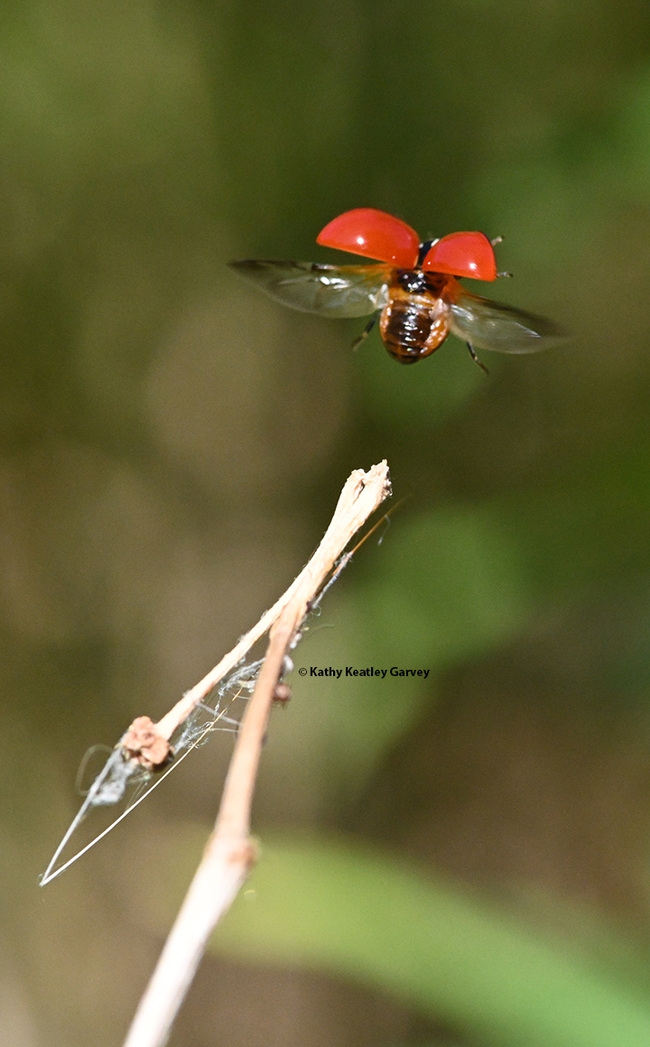
- Author: Kathy Keatley Garvey
Ladybug, ladybug fly away home
Your house is on fire and your children are gone
All except one, and her name is Ann
And she hid under the baking pan.
So says a traditional nursery rhyme traced back to 1744 when it appeared in Tommy Thumb's Pretty Songbook, according to Wikipedia. The first version has it as "Ladybird" instead of "Ladybug" and another version has it "Your house is on fire and your children will burn."
The nursery rhyme was meant to be a chant to shoo away the lady beetle (aka ladybug), according to freedictionarycom. It was "an allusion to the practice of farmers burning their fields after the harvest."
Nowadays, we're more interested in a ladybug's take-off and landings capabilities.
Have you ever tried to photograph the split second when a ladybug spreads its wings? It's not easy to do because insects are unpredictable, and you fingers and your camera shutter speed don't always cooperate, either. Beetle blur!
It's a marvelous feat, though.
Writer Joanna Klein said it best in her May 18, 2017 piece in the New York Times: "The ladybug is a tiny insect with hind wings four times its size. Like an origami master, it folds them up into a neat package, tucking them away within a slender sliver of space between its abdomen and the usually polka-dotted, harder wings that protect it. When it is time to take off, it deploys its flying apparatus from beneath its colorful shell-like top wings, called the elytra, in only a tenth of a second. And when it lands, it folds it back in just two. Switching between flying and crawling many times in a day, the ladybug travels vast distances." (See the news story and watch the video on how a ladybug tucks away its wings.)
Yes, the ladybug is an origami master.
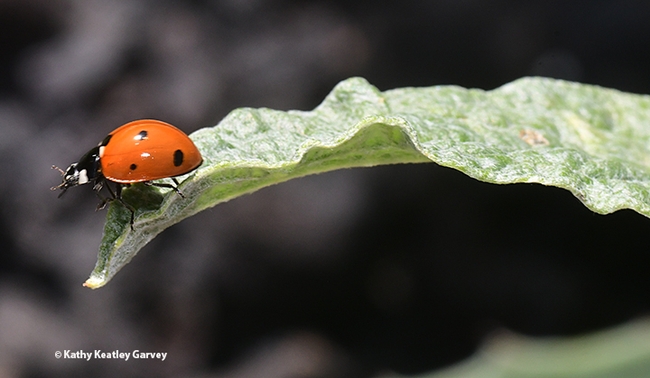
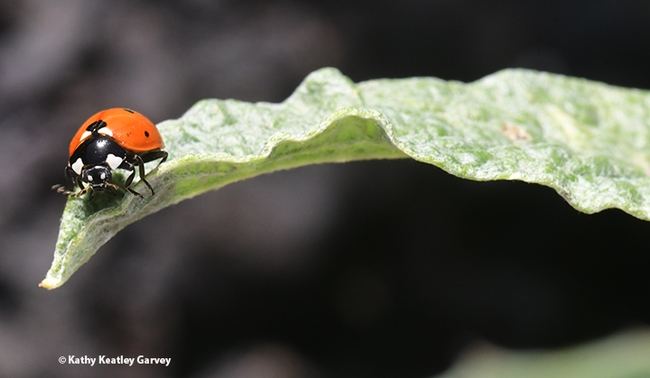
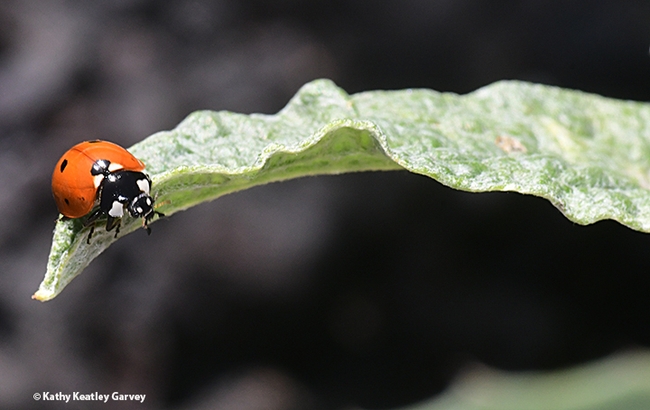
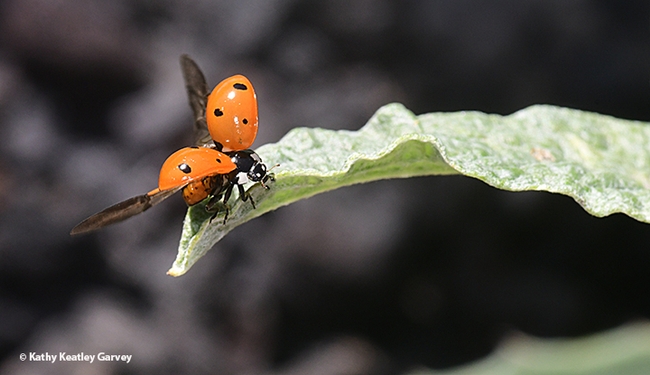
- Author: Kathy Keatley Garvey
Who doesn't love jumping spiders?
They're adorable. No? Well, they are to arthropod enthusiasts, but not so much to their prey.
This one (probably a Phidippus audax, a Bold Jumper) was moving slowly and unobtrusively up a shadowed Vacaville stucco wall on the morning of Jan. 2.
It may have been hunting for prey or simply seeking some sun.
The jumping spider, family Salticidae, is a thing of beauty, but to some folks it's a thing of fright.
Did you catch science writer James Gorman's article on How the Jumping Spider Sees Its Prey in the Nov. 6, 2018 edition of The New York Times?
"If you love spiders, you will really love jumping spiders," Gordon began, humorously adding that "If you hate spiders, try reading this article on dandelions."
"O.K., if you're still here, jumping spiders are predators that stalk their prey and leap on them, like a cat. They are smart, agile and have terrific eyesight."
Gorman pointed out that "It has been clear for a long time that their vision is critical to the way they hunt, and to the accuracy of their leaps. But a lot has remained unknown about the way their eyes work together." He then detailed the newly published research on spider vision by Elizabeth Jakob of the University of Massachusetts and her colleagues.
"Jumping spiders have eight eyes," Gorman gently reminded his readers (who were probably already reading about dandelions). "Two big eyes, right in the center of what you might call the spider's forehead, are the principal ones, and they pick up detail and color. Of the other three pairs, a rear set looks backward, a middle set is as yet a bit of a mystery, and the foremost detect motion."
The spider we saw on the stucco wall certainly detected our motion.
Somewhat like the phrase attributed to Julius Cesar's "I came, I saw, I conquered," our spider "came, jumped and vanished."
Goodbye, spider.
And no, I'm not going to read that article on dandelions.
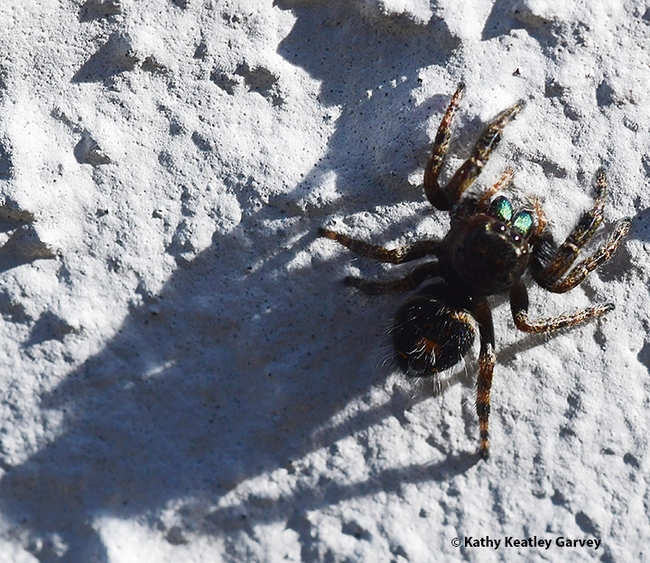
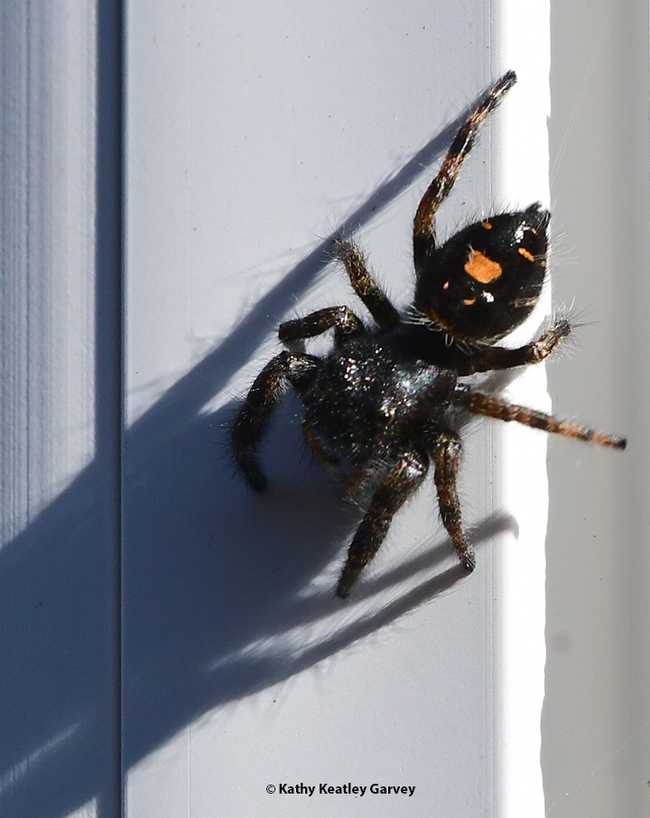
- Author: Kathy Keatley Garvey
The painted ladies are on the move.
Have you seen these migratory butterflies, Vanessa cardui, passing through California on their way to the Pacific Northwest?
Me? No! Zero. Zilch. Zip.
But butterfly guru Art Shapiro, distinguished professor of evolution and ecology, who has monitored the butterfly population of Central California for more than four decades and maintains a research website, has seen approximately 400 painted ladies this season--about 300 today.
All I saw today was a lone cabbage white butterfly flying through our pollinator garden in Vacaville.
Guess the painted ladies didn't get the message. The New York Times, did, though.
"The orange butterflies, called painted ladies, are known to travel annually from the deserts of Southern California to the Pacific Northwest," wrote New York Times reporter Julia Jacobs in a March 17th piece. "This month, people are taking notice because of the sheer size of the migration: Scientists estimate the teeming painted ladies number in the millions."
"Substantial rainfall in the deserts near the Mexican border, where the North American painted ladies lay their eggs, is the reason for the unusually large swarms," Jacobs pointed out. "The rain caused plants to thrive, giving the painted lady caterpillars plenty of food to fuel their transformation, said Art Shapiro, a professor of evolution and ecology at the University of California, Davis."
Shapiro told the New York Times that "the striking thing is they're moving very rapidly and directionally. So it's almost like being in a hail of bullets.”
They're passing through Davis, too. Shapiro headed over to the UC Davis Memorial Union patio today and noticed that "the painted ladies are on the upswing. Many are nectaring, suggesting they're running out of fat, but despite the abundance of potential hosts, saw no oviposiiton. Condition extremely variable, from beat-to-hell to looking almost fresh."
The professor witnessed them passing by the Memorial Union "roughly one every 90 seconds." Ironically, no one seemed to notice them, Shapiro said. Well, it is finals week!
The Los Angeles Times reported March 11 that a "massive swarm of at least 1 billion butterflies is traveling across Los Angeles and neighboring counties at a breathtaking speed of almost 20 miles an hour." They're in a "rush to reach their breeding areas in Oregon."
Shapiro says that years of tremendous wildflower blooms are typically big years for the butterflies. The last big year was 2005. He explains the phenonomen on his website:
"This mass-migrant occurs in much of the Northern Hemisphere. Apparently the entire North American population winters near the US-Mexico border, breeding in the desert after the winter rains generate a crop of annual Malvaceous, Boraginaceous and Asteraceous hosts. The resulting butterflies migrate north. In good years (lots of desert rain) they may do so by billions, interfering with traffic and attracting the attention of the media. 2005 was one of the biggest Painted Lady years in history--perhaps the biggest, but how can we know? At Sacramento at the height of the migration butterflies were passing in one's field of vision at the rate of about 3 per second! 2006, by contrast, was a La Nina year with very little rain in the desert. The butterflies apparently gave up trying to breed there and flew north in February. They tried to breed but mostly were unsuccessful due to bad weather, resulting in only very sporadic individual sightings of their progeny in May.
"Northward-migrating Painted Ladies are provisioned with yellow fat and are reproductively immature," he writes. "They do not stop to feed or have sex until they have burned up their reserves, carried over from the caterpillar stage. They fly in a straight line from SE to NW, like 'bats out of Hell,' and go over obstacles rather than trying to go around them. (On certain days there may be concerted local movements in the wrong direction. We do not understand these.) Painted Ladies tend to fly parallel to the Sierra Nevada, not across it. They enter the Central Valley through the Inyo-Kern lowland or by crossing the Transverse Ranges. They can apparently make it from Bishop to Davis in three days. In some years the migration is heavier in the Great Basin and on the East slope of the Sierra than farther west.
"The Painted Lady moves northward in a generational wave as the season progresses. Frequently it disappears altogether from the lowlands in summer. Beginning in August the movement reverses and butterflies head south toward the desert wintering grounds. The southward migration is a more protracted affair, with plenty of adult feeding and some breeding en route. Numbers tend to be highest east of the crest, on Rabbitbrush blossoms in October."
Well, maybe tomorrow one or more painted ladies will fly my way. Preferably more.
Shapiro just received word of "a major movement through the Kern River Valley. Inyo-Kern is the superhighway from the desert to the Central Valley, so the biggest numbers may yet be on the way."
